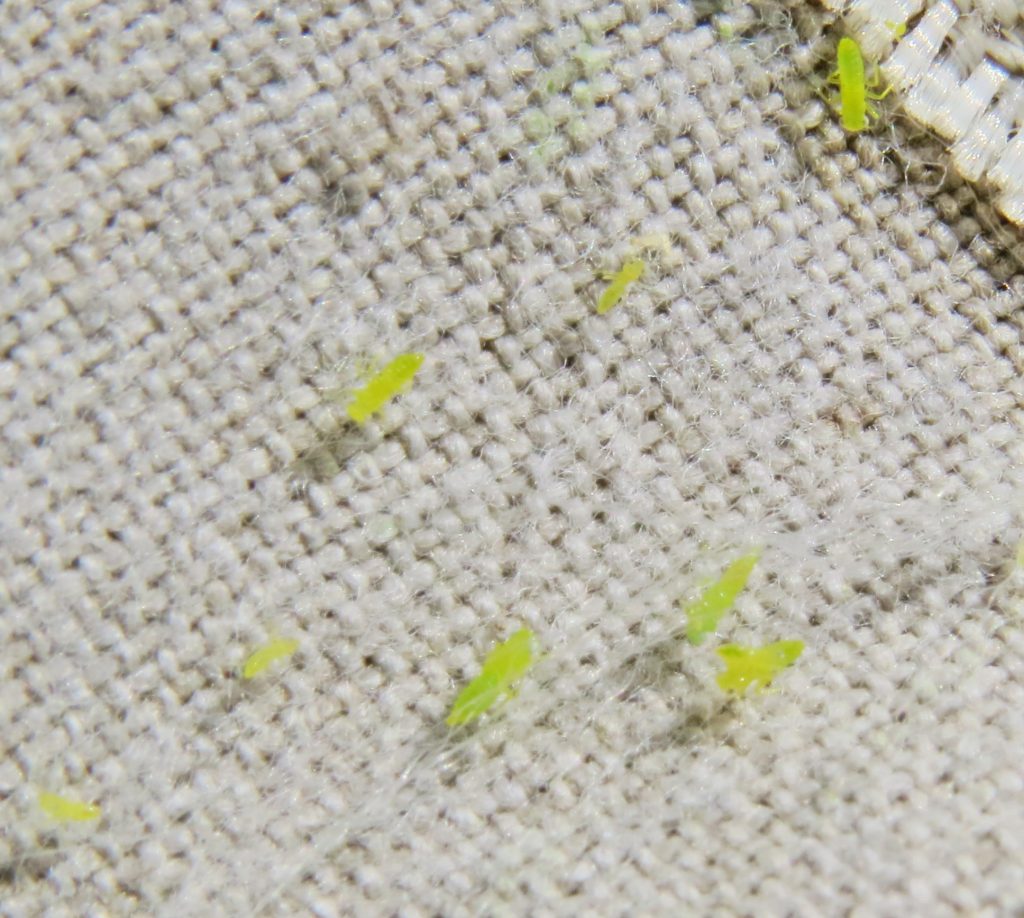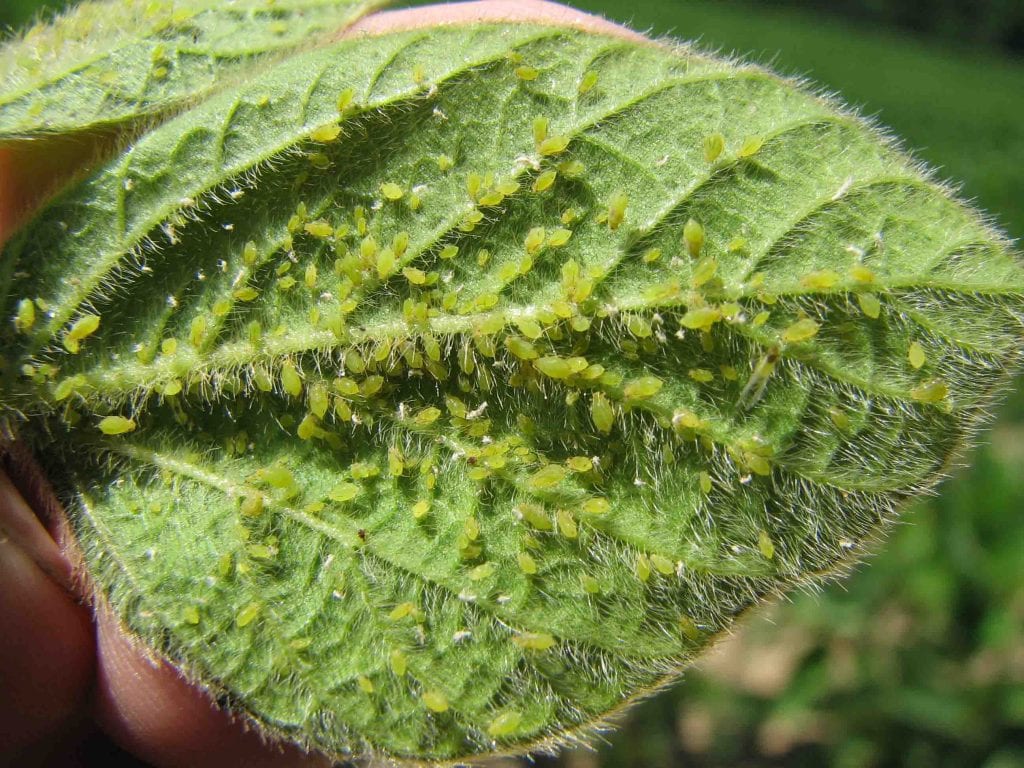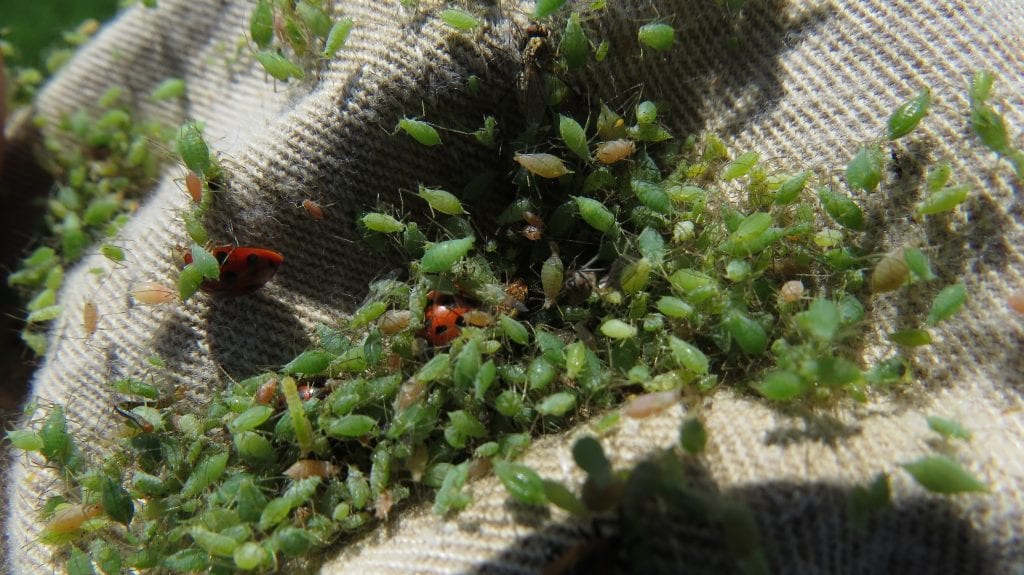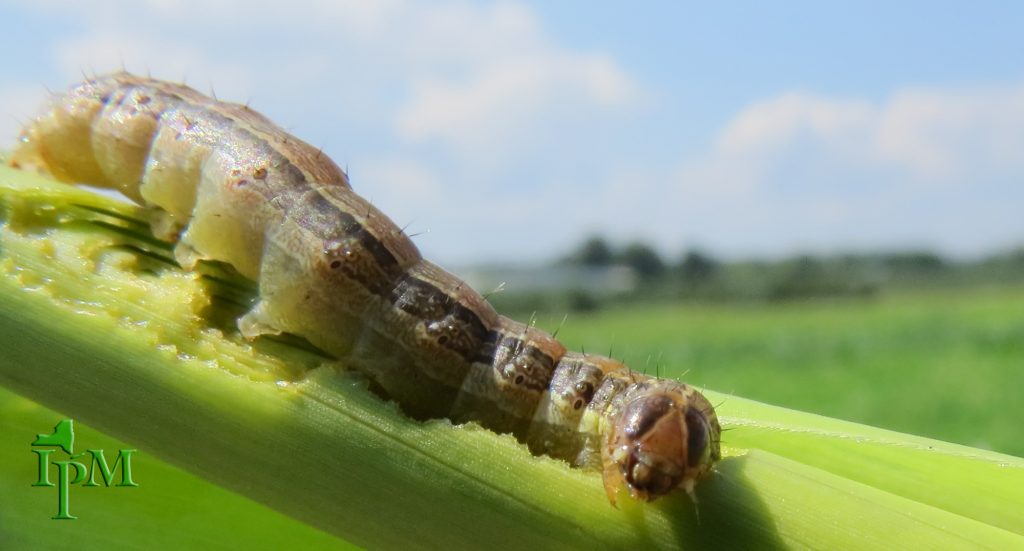NYS IPM Weekly Field Crops Pest Report
Volume 19 Number 13
View from the Field
Western Bean Cutworm (Striacosta albicosta)
The Western bean cutworm moth flight has increased over the last week. This might be the peak flight of the moth for the state. Many traps have increased this week in Northern NY. There are some traps across the state that have decreased.
It is time to get out and scout your corn for small larvae and egg masses. The threshold is five percent of the plants have eggs laid on the leaves. This is an accumulated threshold. Therefore, if you found three percent one week and four percent the next the accumulated percentage would be seven percent infection. This would be over threshold and an insecticide application would be needed. Note this is only for corn grown for grain. There are no thresholds for silage corn.
The following are photos of egg masses and small larvae:
The following is the prediction of current western bean cutworm flights using degree-days. This map was created by Dan Olmstead (NYS IPM-NEWA). https://cpb-us-e1.wpmucdn.com/blogs.cornell.edu/dist/c/5697/files/2020/08/wbc-report-20200803.jpg
Number of Moths Caught by Trap Location Map
Potato Leafhopper (Empoasca fabae)
There are continued reports of potato leafhopper (PLH) over threshold in several fields across NY. For information on scouting/monitoring PLH in alfalfa, view the following video: IPM for potato leafhopper in alfalfa-Video
Soybean Aphids (Aphis glycines)
There were reports of soybean aphids starting to show up in soybeans. While the populations are low, they can increase quickly. They are the only aphids that infest soybeans in North America.
Remember that the 250 aphids/plant economic threshold is for between the R1 and R5 stage of soybean growth. After the R5 stage of growth, research has shown control is not necessary.
Pea Aphids (Acyrthosiphon pisum)
There are reports of high pea aphid levels. Remember one of the reasons we generally do not have issues with pea aphids is that there are many natural enemies. If a field is sprayed, it will kill all of those natural enemies. Here are thresholds for pea aphids in alfalfa.
Purdue University Thresholds
- Twenty sweeps (1 sample) taken randomly in five locations
- Determine the volume of aphids caught in each sample
The threshold for pea aphids
Average Volume/ 20 Sweeps Description of Population
0 to Few Very Low
Less than ½ cup Light
½ to 1 cup Moderate
More than 1 cup Heavy
If “moderate” to “heavy” infestations:
- Inspect 25 random stems
- Count the number of pea aphids on each stem.
- Count all parasitized aphids
- Determine the length of alfalfa
Insecticide may be needed if:
- aphid populations are moderate to heavy
- there are less than 10% parasitized aphids
- lack of predators
- stems are less than 14 inches
Source of information: Pea Aphid-Purdue University Field Crops IPM
Fall Armyworm (Spodoptera frugiperda)
There was some fall armyworm damage identified this week in corn research plots. For the most part, fall armyworm does not do much damage to field corn.
Spider mites
Spider mites, Japanese beetles and grasshoppers persist at low to moderate levels on soybeans across the state.
Corn diseases
Several corn diseases were reported this week across the state at low to moderate levels.
Soybean diseases
Several soybean diseases were reported this week across the state at low to moderate levels.
Degree Days Base 50 from March 1, 2020 to Aug. 3, 2020
| Station Location |
(Base 50) March 1 |
| Canton | 1551 |
| Ceres | 1421 |
| Chazy | 1487 |
| Geneva | 1692 |
| Highland | 1872 |
| Ithaca | 1601 |
| Kinderhook | 1834 |
| Malone | 1430 |
| Massena | 1528 |
| Oriskany Falls | 1599 |
| Red Hook | 1842 |
| Versailles | 1602 |
| Watertown | 1555 |
Clipboard Checklist
Keith Waldron, NYS IPM
General
*Walk fields to check general field condition, weed, vertebrate and other issues
*Watch for crop maturity, stand assessments, weed escapes, nutrient deficiencies, lodging issues
Alfalfa:
*Evaluate established legume stands for approximate days until harvest
*Monitor potato leafhopper, foliar, systemic and crown rot diseases.
*Monitor new seedings for potato leafhopper, pythium blight, phytopthora root rot.
Small Grains:
*Monitor grain fields for growth stage, disease and lodging issues, grain maturity, harvest timing
*Record diseases present, location and types of weed escapes
Corn:
*Monitor for mid-season corn pests including European corn borer, corn rootworm, western bean cutworm, slugs, foliar diseases such as northern corn leaf blight and gray leaf spot, weed issues, nutrient deficiencies, vertebrate damage.
Soybeans:
*Monitor for soybean aphid, defoliators, foliar diseases, white mold, weed issues, vertebrate damage
Pastures:
*Check water sources, mend fences as needed.
*Check crop growth, clip pastures between grazing as needed
*Monitor for invasive species, plants harmful to livestock
*Review/Plan rotations
Storage:
* Check stored grain bins for temperature, moisture and signs of mold and insects. Aerate, core, transfer grain or treat as necessary
* Clean and disinfect empty storage bins in preparation for grain harvest
*Check forage allocation and anticipate feed program adjustments as forages from previous year are used up
*Mow around storage bins and facility to minimize pest hiding places
Dairy Cattle Barn Fly Management:
*Monitor animals and barn area for house fly, stable fly and other pest management needs including presence of rodents and birds.
*Check facilities for favorable fly breeding conditions: (organic matter + moisture): leaks in watering systems, roof gutters for leaks and potential overspill, drainage,
*Sanitation, sanitation, sanitation – clean animal resting areas, feed troughs, minimize source of moist organic matter i.e. fly breeding areas in barn and in adjacent animal loafing yard
* Continue fly monitoring: install “3X5″ index card fly speck monitoring cards throughout barn
*Use, replenish, replace fly management materials: sticky fly tapes/ribbons, insecticide baits, natural enemies (parasitoids), fly population monitoring (3 x 5) spot cards
*Consider purchase and release of Muscidifurax raptor and/or M. raptorellus natural enemies of house and stable fly pupae.
Dairy Cattle on Pasture:
*Monitor animals for presence of face flies, horn flies and stable flies. Action guidelines: face flies (average 10 per animal face), horn flies (average 50 / dairy per animal side, 200 / beef cattle per animal side), stable flies average 10 per animal (all four legs)
*Check feed bunk / water source locations for signs of stable fly breeding (moist undisturbed organic matter – spilled feed, round bales, etc.), minimize source of moist organic matter i.e. fly breeding areas in barn and in adjacent animal exercise yard.
*Check pasture for forage quality / quantity, rotate as appropriate
*Check pasture for vegetation poisonous to livestock
*Consider use of pasture fly traps to help reduce deer, horse and stable fly populations
Event: Online Tour of Ardent Flour Mill, Port of Albany
Tuesday August 25th, 12:30 – 1:00 pm OR 7:00 – 7:30 pm
Same Tour held at two different times.
Free of charge.
This meeting WILL NOT be recorded to view later.
Ardent Mills is the largest flour mill east of the Mississippi. They would like to source New York wheat. This is an opportunity to learn about the mill.
- Video tour of Ardent Mill
- Introduction to the Food Safety Modernization Act
- Wheat Quality Testing
- Wheat Grading Standards
Pre-Registration is REQUIRED online at https://caahp.ccext.net/civicrm/event/info?reset=1&id=93
You will receive an email with a link and passcode for the Ardent Tour and ALSO a link and passcode for a Practice Zoom. The Practice Zoom will be on Monday August 24 between 12:30 and 1:00 pm and again between 7:00 and 7:30 pm. Connect to the Practice Zoom and say hello, ask questions, see how it all works.
For info and questions, contact Aaron Gabriel, adg12@cornell.edu, 518-380-1496
Ardent Mill information is available at:
ardentmills.com, https://ardentmills.com/our-facilities/new-york/albany-mill/
This material is based upon work supported by the National Institute of Food and Agriculture, U.S. Department of Agriculture, through the Northeast Sustainable Agriculture Research and Education program under subaward number SARE LNE20-396.










